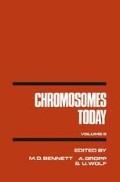Abstract
It seems appropriate to begin this discussion by examining the kinds of major genomic changes that have happened in the course of amphibian evolution, and to segregate those that may have been expected to contribute to the divergence and isolation of species from those that are more likely to have followed on after primary speciation events. In the present context, a genomic change is considered to be “major” if its consequences are clearly detectable at the cytological level and are likely to constitute insurmountable reproductive barriers between species or groups.
Access this chapter
Tax calculation will be finalised at checkout
Purchases are for personal use only
Preview
Unable to display preview. Download preview PDF.
References
Bennett, M. D. 1982. The spatial distribution of chromosomes. In Kew Chromosome Conference II., P. E. Brandham and M. D. Bennett, eds., 71–80. London: George Allen & Unwin.
Britten, R. J. and E. H. Davidson 1971. Repetitive and non-repetitive DNA sequences and a speculation on the origins of evolutionary novelty. Quart. Rev. Biol. 46, 111–133.
Callan, H. G. 1972. Replication of DNA in the chromosomes of eukaryotes. Proc. R. Soc. Lond. 1981, 19–41.
De Weese, J. 1975. Chromosomes in Eleutherodactylus (Apura, Leptodactylidae). Mamm. Chrom. News1. 16, 121–123.
Dover, G. A. 1982. Molecular drive: a non-Darwinian model of evolution. Nature (Lond.) 299, 111–117.
Dowsett, A. P. 1983. Closely related species of Drosophila can contain different libraries of middle repetitive DNA sequences. Chromosoma (Berl.) 88, 104–108.
Goin, 0. B., C. J. Goin and K. Bachman 1968. DNA and amphibian life history. Copeia, 532–540.
Highton, R. 1962. Revision of North American salamanders of the genus Plethodon. Bull. Fla. State Mus. 6, 235–267.
Horner, H. A. and H. C. Macgregor 1983.0 value and cell volume: their significance in the evolution and development of amphibians. J. Cell Sci. in press.
Macgregor, H. C. 1978. Some trends in the evolution of very large chromosomes. Phil. Trans. R. Soc. Lond. B283, 309–318.
McFarlane, P. W. and H. G. Callan 1973. DNA replication in the chromosomes of the chicken, Gallus domesticus. J. Cell Sci. 13, 821–839.
Macgregor, H. C., S. Mizuno and M. Vlad 1976. Chromosomes and DNA sequences in salamanders. In Chromosomes Today, P. L. Pearson and K. R. Lewis, eds., 331–339. New York: John Wiley & Sons.
Mizuno, S. and H. C. Macgregor 1974. Chromosomes, DNA sequences, and evolution in salamanders of the genus Plethodon. Chromosome (Berl.) 48, 239–296.
Mizuno, S., C. Andrews and H. C. Macgregor 1976. Interspecific “common” repetitive DNA sequences in salamanders of the genus Plethodon. Chromosoma (Berl.) 58, 1–31.
Morescalchi, A. 1980. Evolution and karyology of the amphibians. Boll. Zool. 47 (suppl.), 113–126.
Rechavi, G., D. Givoli and E. Canaani 1982. Activation of a cellular oncogene by DNA rearrangements: possible involvement of an IS-like element. Nature Mond.) 300, 607–610.
Schmid, M. 1978. Chromosome banding in Amphibia. 1. Constitutive heterochromatin and nucleolus organizer regions in Ranidae, Microhylidae and Rhacophoridae. Chromosoma (Berl.) 68, 131–148.
Schmid, M. 1980. Chromosome banding in Amphibia. IV. Differentiation of GC- and AT-rich chromosome regions in Anura. Chromosome (Berl.) 77, 83–103.
Schmid, M., J. Olert and C. Klett 1979. Chromosome banding in Amphibia. III. Sex chromosomes in Triturus. Chromosome (Berl.) 71, 29–55.
Smith, G. P. 1973. Unequal crossing over and the evolution of multigene families. Cold Spring Harbor Symp. Quant. Biol. 38, 507–514.
Smith, G. P. 1976. Evolution of repeated DNA sequences by unequal crossing over. Science 191, 528–535.
Summerbell, D., J. H. Lewis and L. Wolpert 1973. Positional information in chick limb morphogenesis. Nature (Lund.) 244, 492–496.
Thiebaud, C. H. and M. Fischberg 1977. DNA content in the genus Xenopus. Chromosome (Berl.) 59, 253–257.
Uzzell, T. M. 1964. Relations of the diploid and triploid species of the Ambystoma jeffersonianum complex ( Amphibia, Caudata). Copeia 2, 257–300.
Wake, D. B. 1966. Comparative osteology and evolution of the lungless salamanders family Plethodontidae. Mem. Southern Calif. Acad. Sci. 4.
Yunis,J. J. 1983. The chromosomal basis of human neoplasia. Science 221, 227–235.
Author information
Authors and Affiliations
Editor information
Editors and Affiliations
Rights and permissions
Copyright information
© 1984 The Organising Committee of the VIII International Chromosome, Conference, Lübeck
About this chapter
Cite this chapter
Macgregor, H.C. (1984). The evolutionary consequence of major genomic changes in Amphibia. In: Bennett, M.D., Gropp, A., Wolf, U. (eds) Chromosomes Today. Springer, Dordrecht. https://doi.org/10.1007/978-94-010-9163-3_23
Download citation
DOI: https://doi.org/10.1007/978-94-010-9163-3_23
Publisher Name: Springer, Dordrecht
Print ISBN: 978-94-010-9165-7
Online ISBN: 978-94-010-9163-3
eBook Packages: Springer Book Archive

